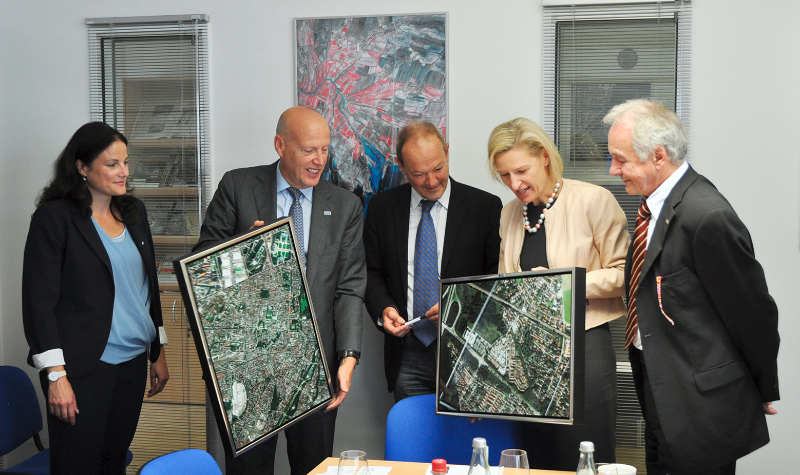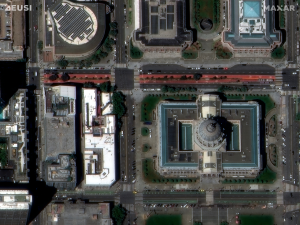MEP Sees Growing Responsibilities for High-Precision Satellite Observation Technology
- European Space Imaging
- 6 August, 2015
Dr. Angelika Niebler visits European Space Imaging.
Europe’s leading provider of high-resolution satellite imagery received a visit last Tuesday from Dr. Angelika Niebler, Member of the European Parliament who wanted to gain an insight into the activities of the medium-sized company in Munich.
Dr. Niebler was particularly interested in understanding the diverse European applications for optical satellite images in the quality of aerial photographs taken from around 700 kilometers above the Earth. Subsequent they jointly discussed the direction of future developments in the market of high-resolution satellite images.

Dr. Angelika Niebler (second from right) during a visit to European Space Imaging GmbH. From left: Director of Sales and Marketing Michaela Neumann, CEO Adrian Zevenbergen, Senior Advisor Dr. Wolfgang Steinborn and Senior Advisor Dr. Wolfgang Bätz.
European Space Imaging supports significant programs of the European Commission and the European Council and their agencies with the satellite images, currently the most detailed commercially available. These include among others, the Joint Research Centre (JRC), the European Environment Agency (EEA), the European Maritime Safety Agency (EMSA) and the European Union Satellite Centre (EU SATCEN). The satellite data provides important policy decision-making support in areas such as agriculture, regional and urban structural funding, humanitarian aid, disaster management, security and not least the protection of the seas.
The company founded in 2002, provides satellite data with a resolution of up to 30 cm, almost equivalent to today’s aerial photographs, however, the coverage is created with the same quality for entire countries and continents. Through its partnership with DigitalGlobe, the American owner of the satellites, and the German Aerospace Center (DLR), European Space Imaging operates its own local ground station for direct tasking and timely control of Earth observation satellites and the reception of the image data over Europe and North Africa. A great advantage for this coverage is the geographical location of the ground station at Oberpfaffenhofen near Munich.
“This gives our customers great flexibility and high efficiency in recording cloudless and timely images. Since the satellites fly over Europe several times a day a small team is specialized to respond to short-term customer requests and immediately process and deliver the data,” explains CEO Adrian Zevenbergen.
Dr. Niebler was impressed by the diverse range of applications for the imagery and appreciated the high motivation and customer friendliness of the team. In the future, she sees through the growing information needs in Europe considerably more tasks for such Earth observation and considers it important to support the development of this technology and to promote further.
Related Stories

Maxar Intelligence Releases First Images from WorldView Legion as EUSI Prepares Munich Ground Station for European Downlink
Satellite Imagery © 2024 Maxar Technologies Provided by European Space Imaging Munich, Germany – Maxar Intelligence released the first images collected by the highly anticipated

Satellite Imagery for Emergency Management
The use of satellite imagery for emergency response and management is invaluable. Both optical and SAR images help rescuers save lives when disasters happen, assist with damage assessments, and in many cases contribute to successfully preventing and predicting emergencies. Which events can be prevented? How exactly do first responders use satellite images? When are they better than other methods? We have summarised our 20+ years of experience in this article.

Satellite Imagery as a Valuable Tool for the New Common Agricultural Policy 2023–2027
On 1 January 2023, the new Common Agricultural Policy for years 2023–2027 entered into force. Hand in hand with the provided subsidies goes the necessity for monitoring and controls, which falls to the individual Member States. Therefore, an efficient, reliable, and cost-effective source of data is needed. Such source is Very High Resolution (VHR) satellite imagery. It allows you to conduct in-depth analysis of plant and soil conditions, map land use at wide scales with incredible detail and accuracy, and ensure that agricultural goals are being met.

MGP Pro: The Next Generation of SecureWatch for On-demand Access to VHR Imagery
MGP Pro provides unrivalled coverage, quality and flexibility. Its subscribers can access over 3 million square kilometers of daily image collections, plus more than 6 billion sq km of archived imagery at up to 30 cm resolution.





